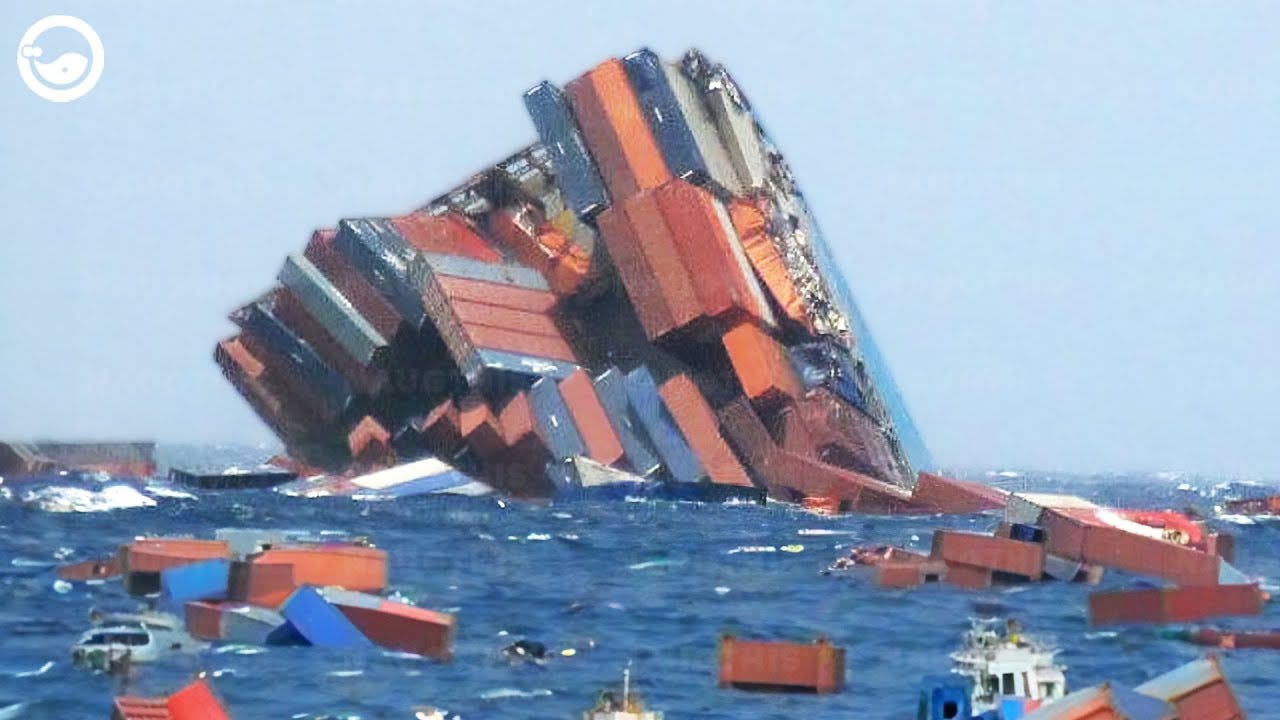A cargo ship taking out a major bridge in Baltimore, killing people in the process, is indeed a catastrophe, but it shouldn’t be all that surprising. Statistically, given the immense scale of mega-ships, these kinds of things are going to happen.
In a quest to transport more and more stuff around the globe to feed the beast of consumerism and capitalism, shipping companies have consistently increased the size of cargo ships. According to maritime analysts the number of 20-foot cargo containers that ships can carry has increased 1,500 percent in the past fifty years. In 2006, Maersk, one of the world’s largest container shipping companies, introduced its E-series which can carry 15,000 containers, doubling the capacity of the previous largest ships.
The ship that took out the Baltimore bridge and several people’s lives is 985 feet long with a carrying capacity of approximately 10,000 standard-sized metal shipping containers. At the time of the wreck, it was loaded with 4,700 containers. By cargo shipping standards it is considered a mid-sized vessel. Three football fields in length, as long as the Eiffel Tower is tall, is merely mid-sized.
In truth, had it not run into a bridge and killed people, a massive cargo ship getting into trouble and spilling containers into the sea likely wouldn’t have been noteworthy. It is virtually impossible to get accurate data about how many containers are lost at sea each year. The World Shipping Council estimates approximately 1,400 containers lost at sea every year. However, this number seems extremely low particularly when considering just a couple recent incidents:
· In 2013, the MOL Comfort ran into rough weather, cracked in half and eventually burned, dropping a total of more than 4,000 metal shipping containers and 1,500 tons of fuel into the ocean.
· In Nov. 2020, the cargo ship, One Apus, dropped 1,816 containers including 64 carrying hazardous materials into the sea.
Some of you may remember the 2021 fiasco when the Ever Given, one of the largest ever cargo container ships, got caught in strong wind, blown slightly off course, and jammed sideways in the Suez Canal, blocking the shipping lane for a week. At the time, while commentators and economists were speculating about how to get the shipping traffic moving again, I noted that once again the wrong questions were being asked. The question shouldn’t just have been how to get the behemoth moving, but should we be moving such vehicles and masses of stuff, including toxins, in the first place.
In addition to dropping debris and toxins into the world’s oceans, cargo ships run on exceedingly dirty fuel, pumping out greenhouse gas emissions and air pollution (this multiplies enormously when you factor in all the tug boats, port vehicles, etc. associated with the sea freight industry). Cargo ships are also responsible for whale strikes and the underwater noise pollution that harms marine species. Current estimates suggest that approximately 57,000 cargo ships make up the current global fleet. This includes container ships, oil tankers, and chemical tankers. One particular cargo ship specialty is the transport of livestock – living cows, sheep, pigs, etc. According to the Guardian, these are even more susceptible to catastrophic events. Tens of thousands of live animals are crushed and drowned every year in the livestock sea freight industry. One such incident, the Queen Hind ship, drowned over 14,000 sheep.
There is growing interest in finding ways to fuel cargo ships with cleaner fuels, but looking at the bigger picture, that’s the equivalent of putting lipstick on a pig. The very difficult truth is that we will not be able to maintain a livable, vibrant planet given the mania of consumption that currently drives modern civilization and the global economy.
I suggest some of the most significant environmental actions we can take include:
· Adopting hobbies, pastimes, and social outings other than shopping.
· Repairing rather than tossing out and buying new. I’m happy to note my home state, Oregon, just passed a Right-to-Repair law that will at least make it a little harder for companies to force us to buy entirely new products when a piece or part breaks.
· Shopping local. There wouldn’t be demand for all those cargo container ships if we localized supply chains.
· Buying second-hand. Consignment, thrift stores and resale outlets can be treasure troves for good quality clothing, lumber and housing products, dishes, etc. I saved a lot of money using ThriftBooks when I was going through ministerial school.
· When giving gifts, consider experiences, rather than stuff.
Reducing our own consumerism is a form of activism. So is calling out the right question. I wonder if the folks in Baltimore, and our own federal government which has promised to pay for the rebuilding of the Francis Scott Key bridge, are planning to build the new bridge higher and/or stronger to allow for mega-ships? Seems likely, but wouldn’t it be great if they used this moment to ask whether or not mega cargo ships are worth the damage and danger they cause? Just asking.
The main bridge that needs to be rebuilt here is the one connecting humanity’s capacity for technological ingenuity with wisdom in utilizing the technology we’re capable of creating.
P.S.
Here's a video showing some of the massive cargo ship disasters that are sadly not terrible uncommon.
And, just in case you’re interested, here’s a link to the book, The Box, which shows the intentional campaign to shift the world economy onto the back of the now ubiquitous metal shipping containers.
Here’s to humanity gaining some sanity.
Cylvia





How can this brilliance be escalated into a movement?
Great article. Broadens perspective on the Baltimore ship issue.